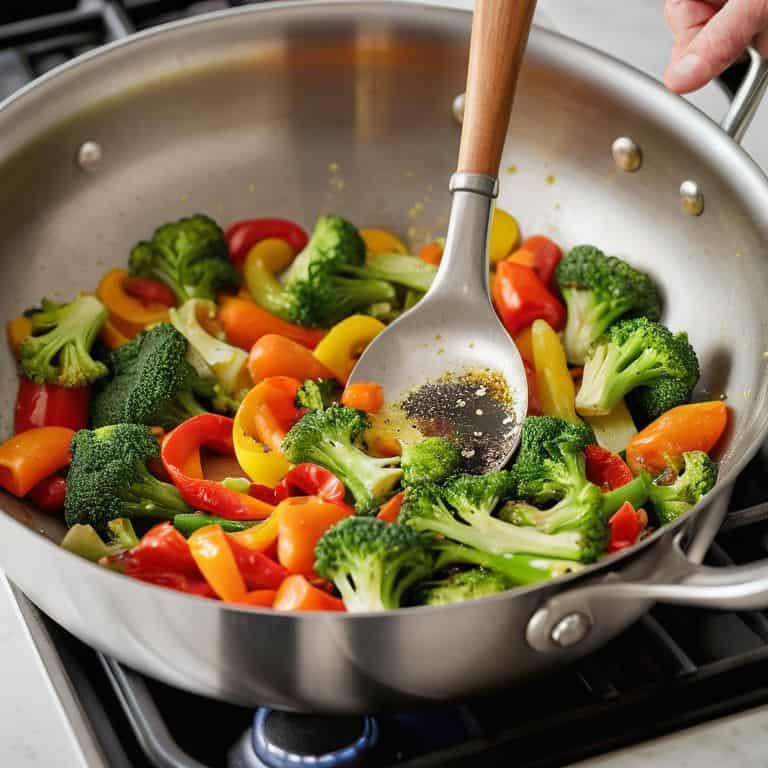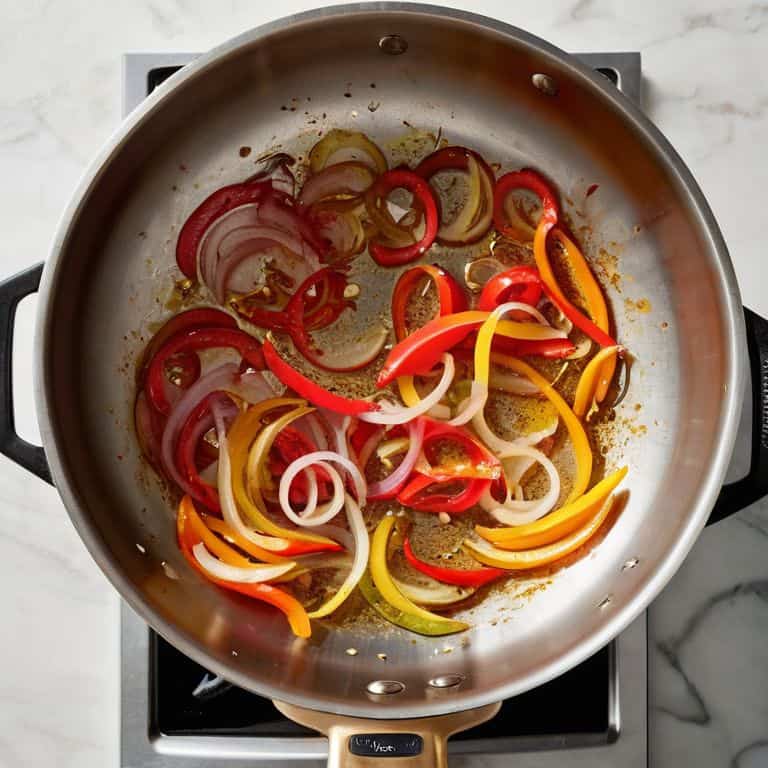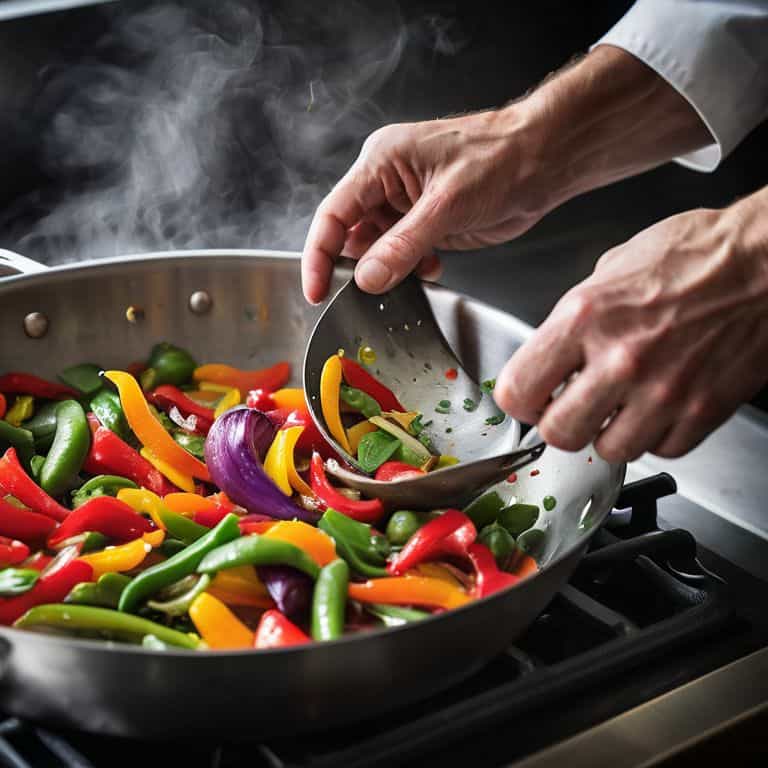As a flight instructor, I’ve seen my fair share of complex topics broken down into simple, understandable steps. But when it comes to cooking, I’ve noticed that the sautéing technique is often shrouded in mystery. What is the sautéing technique, really? Is it just a matter of throwing some ingredients in a pan and hoping for the best? I’ve found that many cooks, even experienced ones, struggle to master this fundamental skill. It’s time to set the record straight and provide a clear answer to the question: what is the sautéing technique?
In this article, I promise to provide you with a no-nonsense guide to sautéing, free from complicated recipes and overly technical jargon. I’ll share my own experiences, both in and out of the kitchen, to help you understand the fundamentals of sautéing. By the end of this journey, you’ll be equipped with the knowledge and confidence to tackle even the most daunting dishes. So, buckle up and let’s dive into the world of sautéing, where the right combination of heat, ingredients, and technique can elevate your cooking to new heights.
Table of Contents
Mastering Sauting Basics

To master the basics of sautéing, it’s essential to understand the fundamentals of this cooking technique. Sautéing is often compared to frying, but the key difference lies in the amount of oil used and the cooking time. Unlike deep-frying, sautéing requires a small amount of oil, which helps to preserve the nutrients in the ingredients. When sautéing vegetables, it’s crucial to choose the right sauté pan materials, such as cast iron or stainless steel, as they can withstand high temperatures and distribute heat evenly.
When it comes to sautéing, the type of cooking oil used is also vital. Different oils have varying smoke points, which can affect the flavor and texture of the dish. For example, olive oil has a relatively low smoke point, making it less suitable for high-heat sautéing. On the other hand, avocado oil has a higher smoke point, making it an excellent choice for stir-fry techniques. By selecting the right oil and cooking technique, you can ensure that your sautéed dishes are not only delicious but also nutritious.
As you practice sautéing, you’ll begin to appreciate the benefits of sautéing vegetables, including the retention of their natural flavors and textures. To achieve this, it’s essential to cook the ingredients quickly over high heat, while constantly stirring and tossing them. This technique helps to prevent the ingredients from burning or becoming mushy, resulting in a dish that’s both healthy and flavorful. By following these simple tips, you’ll be well on your way to becoming a sautéing expert.
Benefits of Sauting Vegetables Daily
When it comes to cooking vegetables, sautéing is an excellent way to preserve their nutrients and flavor. By quickly cooking them in a small amount of oil, you can help retain the vitamins and minerals that are often lost in other cooking methods. This makes sautéing a great way to get the most out of your daily vegetable intake.
Incorporating daily sautéing into your routine can have a significant impact on your overall health and wellbeing. Not only will you be getting more nutrients from your vegetables, but you’ll also be able to add a variety of flavors and textures to your meals, keeping your diet interesting and engaging.
Sauting vs Frying Key Differences
When it comes to cooking techniques, many of us use the terms sautéing and frying interchangeably. However, there are some key differences between the two. Sautéing typically involves cooking ingredients in a small amount of oil over medium-high heat, stirring constantly to achieve a nice brown color.
The main distinction lies in the heat control, as sautéing requires a more precise temperature to prevent burning or undercooking the ingredients. This careful balance allows for a crispy exterior and a tender interior, making sautéing a preferred method for cooking delicate foods like vegetables or seafood.
What Is the Sauting Technique

To truly understand the sautéing technique, let’s start with the basics. Sautéing is a cooking method that involves quickly cooking ingredients in a pan with a small amount of oil or fat. This technique allows for a nice browning of the ingredients, which enhances the flavor and texture of the dish. When comparing sautéing vs frying, the key difference lies in the amount of oil used and the cooking time.
The benefits of sautéing are numerous, especially when it comes to cooking vegetables. Benefits of sautéing vegetables include retaining their nutritional value and achieving a tender yet crisp texture. By using the right cooking oil smoke points, we can ensure that our ingredients are cooked to perfection without losing their nutrients. A good sauté pan material, such as stainless steel or cast iron, can also make a big difference in the cooking process.
As we explore the world of sautéing, we’ll discover various techniques to achieve the perfect dish. From stir_fry techniques to the art of combining ingredients, sautéing is an incredibly versatile cooking method. By mastering the sautéing technique, we can create a wide range of delicious and healthy meals, all while sautéing for nutrition retention. Whether you’re a seasoned chef or a beginner in the kitchen, the art of sautéing is definitely worth exploring.
Saut Pan Materials and Oil Smoke Points
When it comes to choosing the right sauté pan, the material is crucial. I always recommend opting for a stainless steel or cast iron pan, as they retain heat well and can withstand high temperatures. This is essential for achieving a good sear on your ingredients.
The type of oil you use is also vital, as different oils have varying smoke points. This refers to the temperature at which the oil begins to break down and smoke, potentially ruining your dish.
Stir Fry Techniques for Nutrition Retention
When it comes to stir-frying, quick movements are essential to retain the nutritional value of your ingredients. This technique allows for a rapid cooking process, which helps preserve the vitamins and minerals found in your vegetables. By stir-frying, you can also prevent the loss of water-soluble vitamins, such as vitamin C and B vitamins, that are often depleted when foods are boiled or steamed.
To achieve optimal nutrition retention, minimal oil usage is crucial. Using too much oil can lead to a less healthy dish, which defeats the purpose of stir-frying as a nutritious cooking method. By balancing the amount of oil with the cooking time and temperature, you can create a delicious and healthy stir-fry that retains the natural goodness of your ingredients.
5 Essential Tips to Master the Sautéing Technique
- Choose the right pan: Select a sauté pan that distributes heat evenly, such as stainless steel or cast iron, to ensure consistent cooking results
- Preheat properly: Always preheat your pan before adding oil or ingredients to achieve the perfect sear and prevent sticking
- Select the best oil: Pick an oil with a high smoke point, like avocado or grapeseed oil, to prevent burning and add flavor to your dishes
- Don’t overcrowd: Cook ingredients in batches if necessary, to allow for even cooking and prevent steaming instead of sautéing
- Stir with purpose: Stir your ingredients frequently, using a gentle folding motion, to distribute heat evenly and prevent hot spots in the pan
Key Takeaways for Mastering the Sautéing Technique
Sautéing is a versatile cooking method that can be used with a variety of ingredients, including vegetables, meats, and seafood, to bring out their unique flavors and textures
Understanding the differences between sautéing and frying, as well as the benefits of daily vegetable sautéing, can elevate your cooking skills and provide a healthier diet
By choosing the right sauté pan materials and oils, and mastering stir-fry techniques, you can optimize nutrition retention and create delicious, restaurant-quality dishes in the comfort of your own kitchen
Navigating the Skies of Culinary Delight
Just as a steady hand on the yoke keeps a plane on course, a gentle touch with the skillet is what transforms mere cooking into the art of sautéing – it’s about understanding the subtle dance between heat, oil, and ingredients.
Daniel Sato
Taking Your Sautéing Skills to New Heights

As we conclude our journey through the world of sautéing, let’s recap the key principles we’ve covered. From understanding the differences between sautéing and frying, to exploring the benefits of sautéing vegetables daily, we’ve laid the foundation for a lifelong mastery of this essential cooking technique. We’ve also delved into the importance of selecting the right sauté pan materials and oil smoke points, as well as effective stir-fry techniques for optimal nutrition retention. By internalizing these concepts, you’ll be well on your way to becoming a sautéing virtuoso in your own kitchen.
So, as you continue to hone your sautéing skills, remember that the true beauty of this technique lies in its endless versatility. Whether you’re a seasoned chef or a culinary newcomer, the art of sautéing offers a world of creative possibilities, from hearty stir-fries to delicate sauces. As you experiment with new ingredients and recipes, don’t be afraid to push the boundaries of what’s possible – and always keep in mind that, with practice and patience, the perfect sauté is always within reach.
Frequently Asked Questions
What are the essential ingredients and tools needed to start sautéing?
To start sautéing, you’ll need a few essentials: a good sauté pan, some oil with a high smoke point, and your choice of ingredients. I like to keep it simple with olive or avocado oil, and then add in my favorite veggies and seasonings. A spatula and some basic kitchen utensils will also come in handy.
How do I determine the right amount of oil for sautéing different types of food?
To determine the right amount of oil, think of it like adjusting your aircraft’s fuel mixture – you want just the right balance. For delicate foods like fish, use a light touch, about 1-2 tablespoons. For heartier ingredients like vegetables or meat, you can use a bit more, around 2-3 tablespoons. Remember, it’s all about finding that sweet spot for perfect sautéing.
Can sautéing be used for cooking proteins like chicken or beef, and if so, what are some tips for doing it correctly?
Absolutely, sautéing is a great way to cook proteins like chicken or beef. Just like navigating through turbulence, you want to be smooth and controlled. Use high heat, a hot pan, and a small amount of oil to get a nice sear, then reduce heat to cook through. Remember, it’s all about timing and temperature, just like flying an approach.
